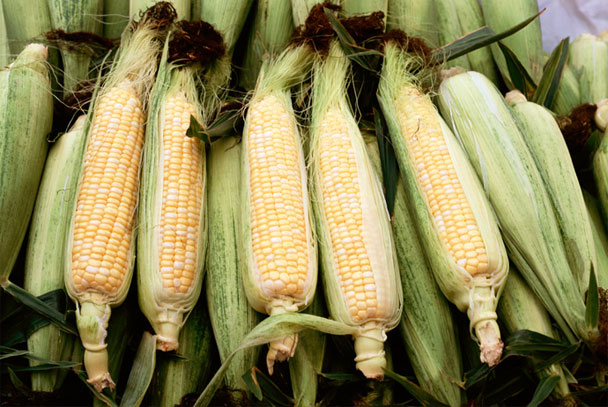Corn! Walking in the cool shade of a stand of sweet corn this week, with the stalks grown higher than my head, I thought for the hundredth time that corn is one kick–ass plant. In fact, if I come back as a plant, I definitely want to be corn. That could be my short–woman complex talking: I’m five feet two inches standing on my toes, and everything about corn is tall and bold. It’s a big feeder, a big grower, a big producer—a grass blown up to gigantic proportions, tricked out with that clever pair of sweet–starchy ears. Past the solstice, corn comes into its full glory, green leaves raised up to the hot sun like a church full of believers waving hands in the air to catch the grace.
My husband Mark and I farm 500 acres in northeastern New York, producing a full diet, year–round, for 170 people via our CSA. We are about as diverse as farms come, raising grain and hay, beef and dairy cattle, chickens, pigs, and draft horses alongside 50 or 60 varieties of fruit and vegetables, from asparagus to zucchini. But more than any other crop we grow, corn is our totem, our flagship plant. For us and our farming neighbors, field corn—the kind used for animal feed, cornmeal, ethanol, and whiskey—is serious business. But sweet corn is our pleasure, the North Country’s own special regional treat, tied to this place as closely as peaches are to Georgia, or cherries to Michigan. In my eyes, a successful summer is defined by a good stand of sweet corn.
This year, we almost missed our chance. Heavy spring rains kept the draft horses and machines out of the fields during planting season. Our field corn—which was supposed to fill 25 acres—never even got in the ground, which means we’ll have to buy the corn we need to get our hogs and chickens through the winter. We grow sweet corn on a much smaller scale, and this year we made a tremendous effort to coax it along, as much for morale as for its food value. We planted an acre of it by hand, because the field was too wet even for the horse–drawn seeder. When the tender shoots emerged, we beat back the weeds, stoked the soil with heavy doses of compost, and put up flashy Mylar scare tape to fend off the crows. When Mark and I walked the fields in July, I’d direct a stream of hope at the knee–high plants for good measure. As July turned to August, the ears tasseled and the kernels grew fat.
Sometimes I think a farm is like a slot machine, its complicated works calibrated to dole out just enough prizes at brilliantly spaced intervals to keep you coming back for more. I’d count among those addictive pleasures the bawling of a newborn calf, the smell of steam from boiling maple sap, and in late summer, the taste of sweet corn that hits the pot just minutes after being picked. For such a sturdy plant, corn, at perfection, is surprisingly ephemeral. Its sugars begin to convert to starch as soon as the ear comes off the stalk. The difference between the kind of just–picked sweet corn you can get at the farmers’ market or a roadside stand and the well–traveled, plastic–wrapped version you often find in a supermarket is so vast it might as well be a different food. One of the redeeming pleasures of farm life is the fact I can put the water on to boil as I head out to the field to pick a dozen ears for our dinner.
Our daughter Jane, who is almost four, is my sweet–corn–picking partner. She is deep in a tutu–and–tiara phase, and has spent the whole summer tromping around the farm in a pair of sparkly red shoes, the glitter worn off now at the toe. The ensemble makes it easier to spot her even when she runs far off between the shady rows to look for garden spiders. I hear her break off a low ear, shuck it, and munch it raw—a farm–kid appetizer. I yell to her to hunt for huitlacoche, the lumpy fungus that is considered a blight by farmers in the United States but a delicacy in corn–worshipping Mexico. Jane shouts back a few minutes later that she’s found an ear of it, and it’s a good one, bulging with alien–looking gray lobes. We’ll take it home and sauté it with butter and green onion. I am as gringa as they come, but my taste in corn is decidedly mexicana. Ask the French about pastry, the Italians about pasta, but look to Mexico for wisdom on corn.
I’m thinking about that as I choose my ears for dinner. In summer’s decline, I crave ears that are as mature as the season feels now, the kind of corn you find for sale on a street corner in Chiapas: ears with hulking kernels that I can sink my teeth into, with a complex corn character. Most farmers here grow the corn that American tastes demand, the extra–sugary hybrid varieties with kernels that pop off into your mouth when you bite. When picked at just the right stage, and eaten very fresh, I guess they deserve their celebrity. But as soon as their sweetness begins to fade, I find there’s nothing to back it up. These modern varieties have gained extra Brix points—the standard measure for sugar content—but lost their substance, the nourishing, nutty depth that makes corn more than a vehicle for salt and butter.



 Pinterest
Pinterest


